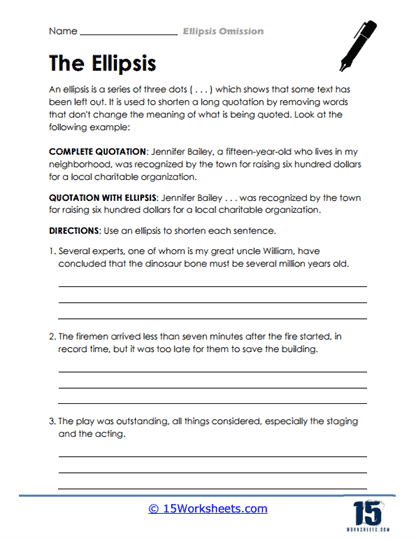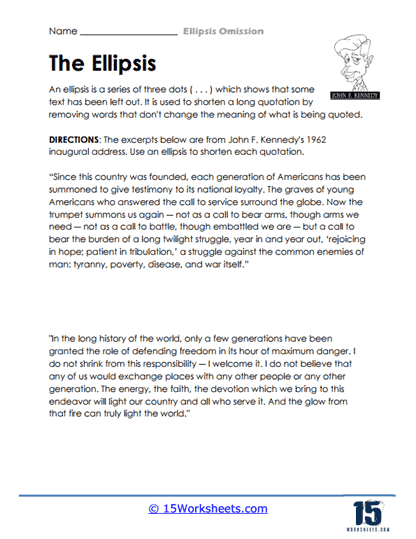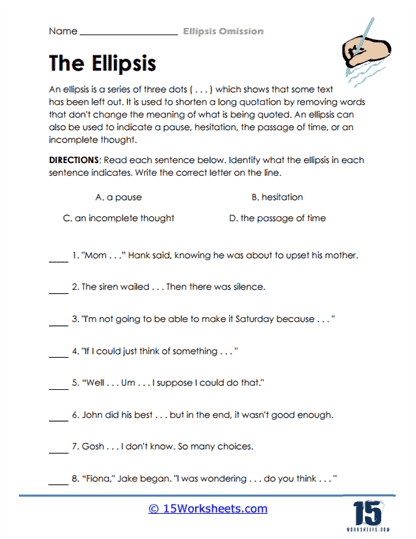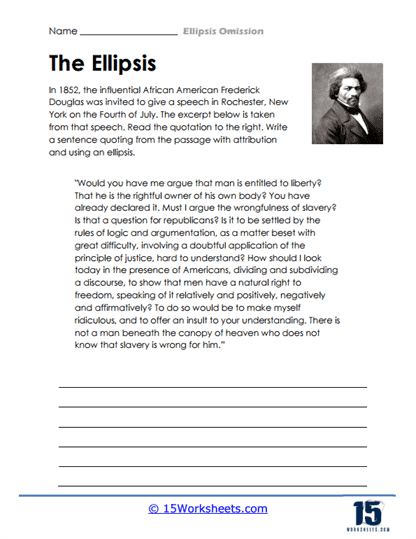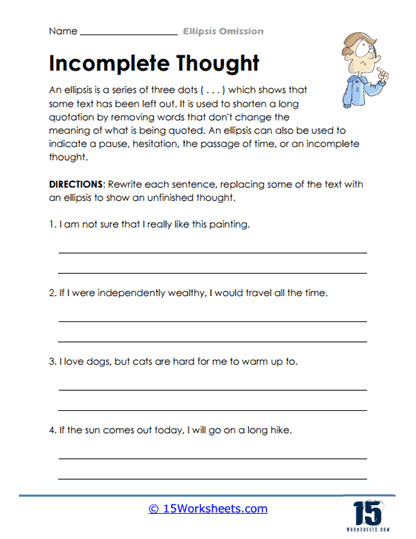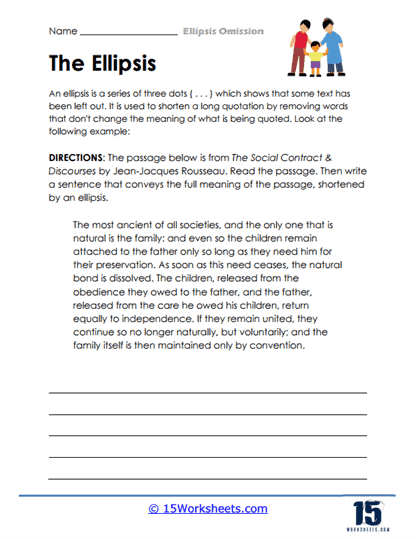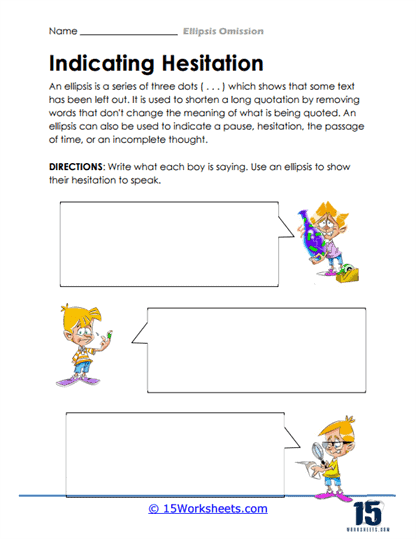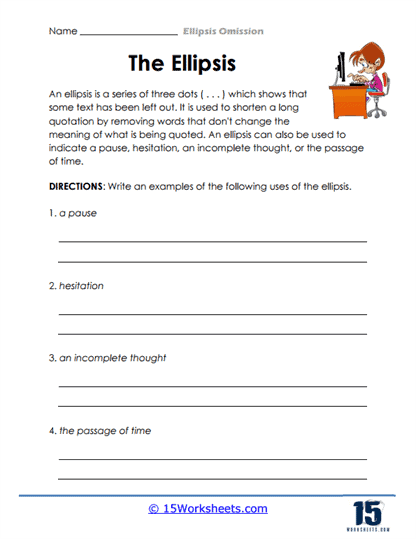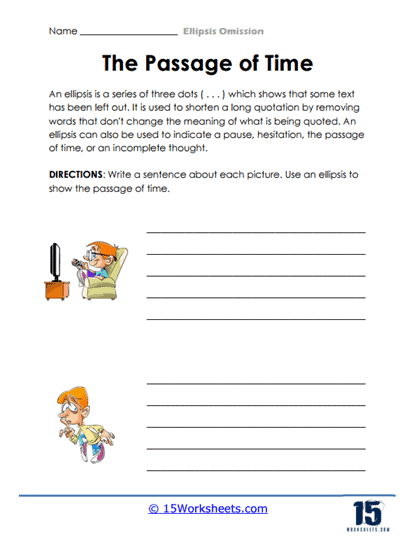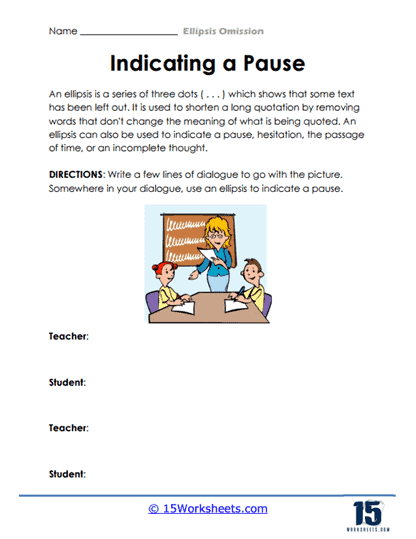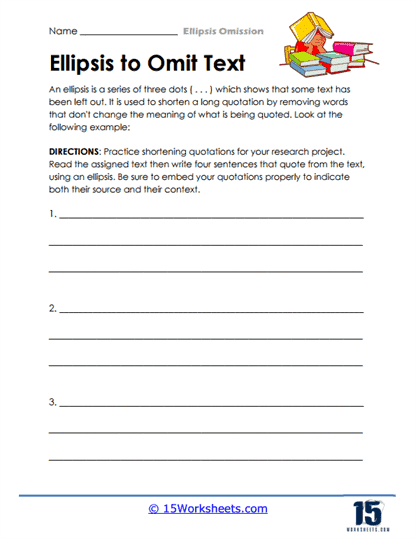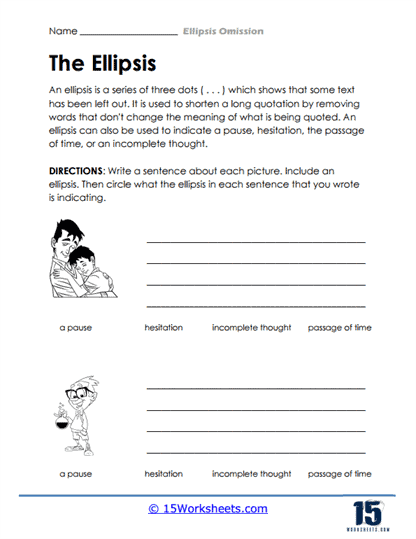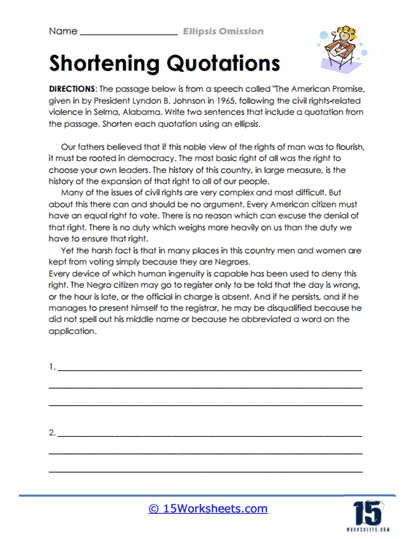Ellipsis Worksheets
All About These 15 Worksheets
We put these worksheets together to help students practice and improve their understanding of ellipses in writing. You might already be familiar with ellipses as punctuation marks that consist of three dots (…) placed in a row. However, ellipsis worksheets can provide you with exercises to further develop your skills in using ellipses correctly. Here’s an explanation of what ellipsis worksheets entail:
Omission of Words or Phrases – One common use of ellipses is to indicate the omission of words or phrases from a sentence or quotation. Ellipsis worksheets often provide sentences or passages with missing parts, and your task is to identify and add the appropriate ellipsis to indicate the missing words or phrases.
Example: Original sentence – “I went to the store and bought apples, oranges, bananas, and strawberries.”
With ellipsis – “I went to the store and bought … bananas, and strawberries.”
Pausing or Trail-off – Ellipses can also be used to show a pause or indicate that a thought is trailing off. In these worksheets, you may encounter sentences or dialogue where you need to determine the appropriate places to include ellipses to convey a sense of hesitation or incomplete thought.
Example: Sentence – “I wanted to tell you something, but…”
With ellipsis – “I wanted to tell you something, but…”
Dramatic Effect or Suspense – Ellipses can be used to create a sense of dramatic effect or suspense in writing. In ellipsis worksheets, you might come across sentences or passages where you need to add ellipses to enhance the tension or build-up of a scene.
Example: Sentence – “He opened the door and saw…”
With ellipsis – “He opened the door and saw…”
Quotations and Citations – Ellipses are often used in quotations or citations to indicate omitted words, phrases, or sentences that are not relevant to the intended meaning. In worksheets, you might be asked to identify or add ellipses in quotations to accurately represent the original text while removing irrelevant information.
Example: Original quotation – “The quote is famous for its inspirational message – ‘Believe you can… and you’re halfway there.'”
With ellipsis – “The quote is famous for its inspirational message – ‘Believe you can… and you’re halfway there.'”
By engaging with ellipsis worksheets, you can practice using ellipses effectively in your writing. These worksheets offer opportunities to identify, add, or interpret ellipses in various contexts, helping you understand their purpose and enhance your overall punctuation skills.
How Do Authors Use Ellipsis Effectively?
Authors use ellipsis effectively in their writing for several reasons. Here are some ways in which authors employ ellipsis to enhance their work:
Indicating Omission – Authors use ellipsis to show the omission of words, phrases, or entire sentences from a quotation or text. This is particularly useful when a complete quote is not necessary or when the omitted portion doesn’t significantly impact the intended meaning. Ellipsis helps authors condense information while maintaining the essence of the original text.
Example – “The professor discussed various theories of psychology, including behaviorism, cognitivism, and … other approaches.”
Creating Suspense or Dramatic Effect – Ellipsis can be used to create a pause or indicate a trail-off in dialogue or narrative. By leaving a sentence or thought incomplete, authors build suspense or evoke a sense of mystery, inviting readers to speculate or anticipate what comes next.
Example – “She entered the room, and there it was… a sight she never expected.”
Depicting Hesitation or Uncertainty – Ellipsis can convey a character’s hesitation or uncertainty in their thoughts or speech. By inserting ellipsis, authors show a pause or a moment of reflection, allowing readers to connect with the character’s emotions and thought processes.
Example – “I don’t know… maybe we should reconsider our decision.”
Expressing Unfinished Thoughts or Trails of Thought – Ellipsis can represent an incomplete or fragmented thought process, illustrating a character’s stream of consciousness or the transient nature of their thinking. This technique is often used in literary works to portray the complexities of human thinking and the way ideas evolve or dissipate.
Example – “As I walked through the forest, surrounded by nature, the beauty of it all… I couldn’t help but feel a sense of awe.”
Conveying Time Passing – Ellipsis can be employed to show the passage of time, especially when an extended period is elapsing without significant events. By using ellipsis, authors can skip over mundane or repetitive activities, maintaining the flow of the narrative.
Example – “Days turned into weeks… weeks turned into months, and still, he searched for answers.”

